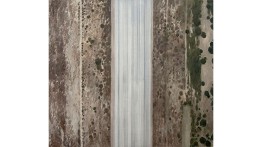Snapshots of the 2013 School of Art Senior Shows
POSTED ON: April 17, 2013
The School of Art senior shows, ongoing until May 13, while a requirement for graduation, otherwise follow the school's commitment to artistic exploration. Students can show anything they wish, either all new work or selections from the past, in any medium that may or may not relate to the student's largest body of work. "Senior shows have a long tradition in the School of Art. The exhibitions are ambitious and allow seniors to mount solo exhibitions or collaborate with colleagues," Dean Saskia Bos says. "In the Spring, when we have exhibitions on all seven floors of the Foundation Building as well as in 41 Cooper Gallery, the shows add dynamism and reveal a sense of energy that grounds us." We asked Dean Bos and Associate Dean Steven Lam for the names of five students to talk to about their show in order to get a better sense of the experience. In these "as-told-to" snapshots Ida Badal, Julie Harris, Mauricio Higuera, Kathryn Marshall and James Sprang discuss the work they chose for the show, how their artwork changed at Cooper and what they will be doing next.
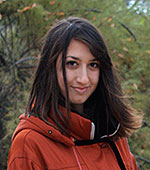 Ida Badal, 23, hails from San Diego. Her show, "DEUCE" closed on March 18.
Ida Badal, 23, hails from San Diego. Her show, "DEUCE" closed on March 18.
DEUCE was a two person painting show with John-Elio Reitman, who is a first-semester senior. I was actually planning on having a solo show until this year when John and I became good friends and started talking to each other about our work. We realized that the way we each approached painting had some interesting parallels. John has a background in photography and his paintings are an attempt to abstract the content and imagery of source photos, whereas my paintings translate photographs more directly as framed images. In the show, our paintings were able to balance and inform each other’s visually and conceptually based on how we use paint.
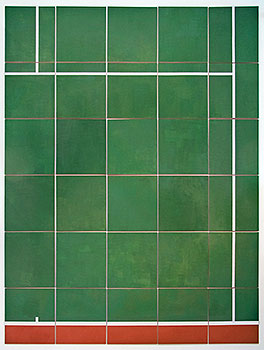 30 by Ida Badal; 30 oil on wood panel paintings
30 by Ida Badal; 30 oil on wood panel paintings
I paint realistically using minimal compositions. I use a lot of landscape imagery and aerial views of exterior spaces. Most of my paintings are sourced from either a photo I have taken or a satellite image that is then cropped to create a composition. The largest piece I made took up the whole wall in 41 Cooper Gallery. It was made up of thirty 4’ x 3.5’ oil paintings on wood panels that all together formed a quarter of a tennis court to scale.
When I came to Cooper, I knew that I wanted to paint. But the way that I approach painting has completely changed. My work has gotten more and more specific. I used to make abstract paintings but I felt that the concepts I was interested in were not being communicated clearly. So I slowly started using more imagery. And it just made sense that the imagery I chose was of spaces I had personal connections to.
I am trying to figure out what my next step is. I miss California a lot but I feel I should stay in New York a little longer and see how it goes. I just want to keep painting.
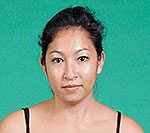 Julie Harris, 21, came to Cooper Union from Maryland. Her exhibition, "Extra Medium," focused on graphic design.
Julie Harris, 21, came to Cooper Union from Maryland. Her exhibition, "Extra Medium," focused on graphic design.
Graphic design is often a collaborative effort in which the work begins with a specific problem from an external context, so the work is not completely yours from the start. Displaying a variety of design work in an exhibition is difficult because of how unique each solution is. I had to find a way to accommodate many types of work in the show that included identity, type, and information design.
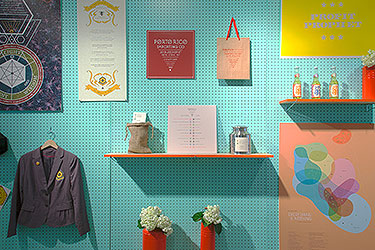 Extra Medium by Julie Harris; Installation view
Extra Medium by Julie Harris; Installation view
I covered the main wall of the second floor lobby with pegboard, painted a turquoise color and displayed most of the work on it. It was like a mural, nearly an independent piece on its own. I also created two sawhorse tables with bean-shaped tabletops. These tables had drawings and books on them. The space was intended to feel like a workshop or garage where things are created, moved, and stored. It also felt like a picnic. I wanted to make the show joyful and engaging, and I think my sensibilities and overall affection for color showed through.
I came to Cooper interested in graphic design, but I knew this might change and I left myself open to what foundation classes taught me. In fact, my studio practice has been shaped by having taken many types of courses at Cooper. At this point I consider myself a graphic designer with, I hope, a broader mindset and skill set than if I had focused on just that. I have always loved graphic design and I imagine continuing with it in New York after graduating.
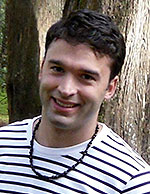 Mauricio Higuera, 28, originally from Medellin, Colombia moved to the U.S. when he was 13. His show, titled "Suspending Duress," opens this week.
Mauricio Higuera, 28, originally from Medellin, Colombia moved to the U.S. when he was 13. His show, titled "Suspending Duress," opens this week.
The works in my senior show are mostly paintings using oil on linen. Some of them hang on the wall and some lean against it. If you look at them you will think they are abstract expressionist but they are more a take on the legacy of abstraction and witnessing. They are performances of abstraction verging on representation. During a recent return to Colombia I saw how my painting resembled the provisional housing over there. There are a lot of displaced people in the cities. If you look at the makeshift housing you see that the first floor is concrete and the second floor is wood and as it goes up it gets more and more provisional. I saw that the way I was making painting was very similar to this.
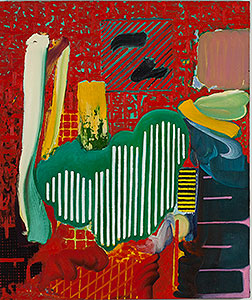 Night Attack by Maurico Higuera; Oil on linen
Night Attack by Maurico Higuera; Oil on linen
This surprised me because this is something I kept denying: my work as a Latin American or anything to do with Colombian culture. Because of my experience being ten years as an undocumented immigrant, I tried to avoid talking about where I was from or allowing people to view me as different. But I think my experience of Colombia, like my experience anywhere, is in my body. My work is very much body-oriented. I don't work from photographs. I work from perceptions, or readings of life experiences and artworks. It's almost as if I was recreating a city. I always thought it was New York City that I was painting but now it is clear to me that my past experience in Medellin resurfaces repeatedly in the work. The result is hard to pin point, but one could say that there is a search for the meaning of home in these paintings.
I have had three weeks since returning from Colombia to put the show together. It's been very exciting. The pressure is there but it is good pressure. It is pressure that makes me do better work. It is mostly new work, with a few pieces from the previous semester. I've accomplished a lot at Cooper and I want to celebrate everything that I have learned. Coming to Cooper was a big deal to me. When I came here I was undocumented. Cooper was the only place that I could come to. Cooper has given me access to all the resources I needed to advance my personal project, which I think is a project of liberation.
After this I am going to enter Rutgers' MFA program. My next project will be to document and research provisional housing in Colombia, and explore the relationship between violence and architecture.
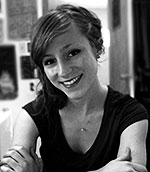 "Moving Target," a group show of which included Kathryn Marshall, Noemi Bilger and Victor Fernandez, ran in the 41 Cooper Square Gallery during the last week in March. We spoke with Ms. Marshall, 21, who comes from New York City.
"Moving Target," a group show of which included Kathryn Marshall, Noemi Bilger and Victor Fernandez, ran in the 41 Cooper Square Gallery during the last week in March. We spoke with Ms. Marshall, 21, who comes from New York City.
Noemi Bilger and I had been working together since last Fall, so our collaboration for the show was a continuation of that work. Noemi and I were an effective team, though we felt in order to use the expansive 41 Cooper Gallery space to its fullest potential, our group called for a third member. We asked Victor, whose aesthetic and attention to color we related to, to exhibit his paintings along with our collaborative and solo pieces. Happily, we all worked exceptionally well together.
Chroma-Choreography by Kathryn Marshall and Noemi Bilger
The collaborative piece Noemi and I produced is a video of an original performance we recorded in a studio earlier this winter. In the 10-minute video-dance piece, we were each cloaked in a two-toned (blue & green) chroma-key costume. The costume's specific colors enabled us, in post-production, to replace the fabric's colors with moving-images--giving the costumes a chameleonic nature. Some of the images were of skin, in which we explored the diverse color palette found within flesh tones. Other clips featured colored inks in water as well as animated sequences of changing hues. These varying forms of color, texture and movement created a tension around whether the costume controlled the form within it or vice versa. My focus revolves primarily around color, spectral relationships, and perception, but I am also very interested in microscopy. A principal part of my solo work in the show included images resembling microscopic organisms or biological specimens--all of which I had produced by painting on 16mm film and photographing it.
The most rewarding part of the show was to see all of the works in one space, juxtaposed and engaged in a conversation. I felt they completed a full arc as a cohesive body of work and affirmed that I hadn't been working alone in my studio frantically making these pieces to no avail. It was edifying, too, because it got people talking. They were curious as to how we made things. People wanted to collaborate. Never before had I felt my work held such potential to have a life outside of the show and outside of Cooper.
Before I came to Cooper I was more interested in making art for the sake of the spectacle. So much of the work was conceptually shaky. In leaving Cooper, I have a strongly guided line of research focusing on color, wordplay through video performance, and the conflation of biology and art. There is no singular "answer" to my research so there can be no dead ends. I feel particularly grateful and excited because I no longer rely on the school to provoke me work harder, produce more, and keep exploring.
After graduating I would like to further pursue this collaboration with Noemi Bilger and do more video work. I am interested in continuing to work with others and pursuing other collaborative projects. Unfortunately there are probably going to be a lot of Youtube and Vimeo years. I can deal with that, though. I am optimistic and am looking forward to keep making art.
 James Sprang, 23, originally from Miami, Florida, created a show entitled "Poetics of Gesture" that was on-going at the time we spoke to him last week.
James Sprang, 23, originally from Miami, Florida, created a show entitled "Poetics of Gesture" that was on-going at the time we spoke to him last week.
The show consists of a series of photographs I took that act as records of past performances in which voices are amplified or suppressed or appropriated. In many of the photographs people are performing poems written by me. There was also a performance presented during the opening reception. Four individuals provided four different interpretations of a poem I wrote. In each case the performer invites an audience member over to participate. Two people decided to perform the text conversationally in such a manner that the participant gets caught off guard when they realize the text is predetermined. The third performer claimed that she had found a bunch of letters that had not reached their sender and asked if she could read them to whomever chose to sit with her. She then blindfolded the participant and proceeded to read to them. Then the fourth performer had the text on a music stand, asked the participant to read the text and played an upright bass alongside them extemporaneously.
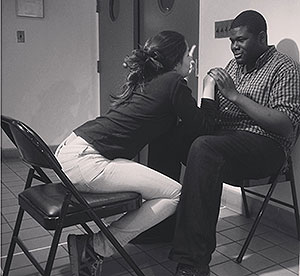 Neil Pritchard performing (with an unidentified woman) at James Sprang's senior show. Image courtesy James Sprang via Instagram
Neil Pritchard performing (with an unidentified woman) at James Sprang's senior show. Image courtesy James Sprang via Instagram
The reason I use photography to record performances is that I am very cognizant of the history of the documentation of performance art and I would like to converse with that history. I also see a photograph of a performance to function in the same way that poetry functions on the page. What I need to invest into that text to make it real for me through speech is similar to the relationship I have to a photograph of a performance. And because my work is about enacting speech and enlivening text it's important for me to use the strategy of photography to record it.
When I came to Cooper I was writing, I was taking photos and I was making performances. But those practices, though they were informing each other in a very chaotic way, had not become married yet. I am happy to see that they have become married and are stronger in that marriage. It wouldn't have happened without this experience. This show was about finally showing everybody what I had been working on for the last three years. My time here at Cooper has been very difficult because my process makes it hard to show the work in a class environment. I can't show the entire process. I can only show fragments. That became very frustrating. So I expected the feedback to be considerably better than the feedback I was getting before. [laughs] And it was.
I don't know what exactly comes next. I like to be organized and prepared but this last year has been so busy. I am going to Trinidad for a month and then I have to figure everything out. I would like work in the education department of a museum, teaching teenagers or doing community outreach.

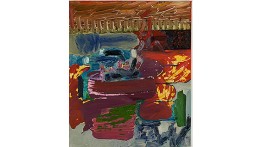
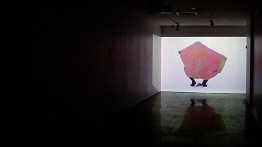
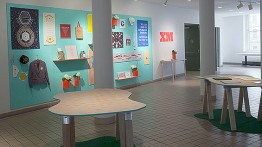
!['Gesture 216 [Individual dancing to the word 'hope.']' photo by James Sprang; 'Gesture 216 [Individual dancing to the word 'hope.']' photo by James Sprang;](/sites/default/files/styles/262w_16_9/public/sprang_lede.jpg?itok=l25l3KvK)
